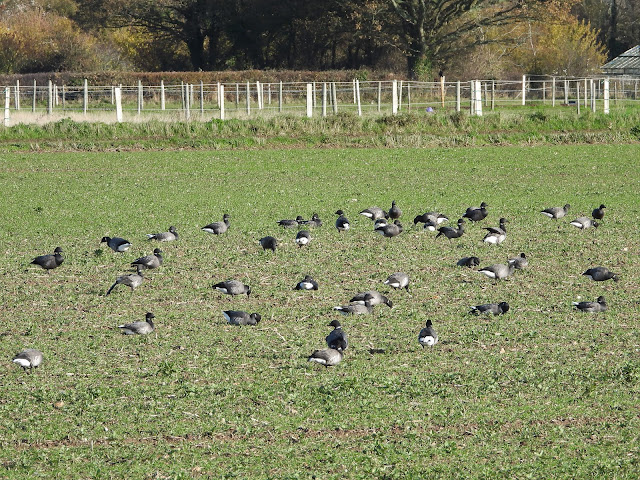Chichester Harbour Trip Report, Guided Birdwatching 16th Nov 2019
I had planned a shorter guided outing to Nutbourne Channel,
Chichester Harbour, although it ended up being not so short! This is an area
where you can often get closer to wetland bird species than at most locations.
There had been a lot of rain recently, fortunately this trip was on a wonderful
winters day, bright and crisp.
The stream that flows into Nutbourne Channel had burst its
diminutive banks. This created a wet habitat that had attracted many moorhens
and a nice selection of teal. The hedges in this area were alive with house
sparrows, more than I had seen for quite some time. From the reedbed around the
stream a water rail squealed its typical cry.
As we walked towards the harbour a flock of several hundred
brent geese were feeding on the farmland to our left. Due to the contour of the
land we initially became aware of a number of goose heads poking up over the top
of the mini-horizon. Their chatter was clear to hear and the sound accompanied
us over most of the walk.
 |
| Part of the Brent Goose flock. |
Once at the harbour wall we were greeted by an array of
ducks and wading birds. The teal appeared to all be on the flooded steam area
mentioned previously but there was a large number of wigeon in the harbour
along with a smattering of handsome pintail. A previously invisible common snipe
decided to vacate the area and called as it appeared to rocket off the
intertidal mud, twisting from side to side every few wing beats as they tend to
do. Other waders present were happily feeding and roosting around the edge of
the tide.
One species of wader was further up the slopes of the mud
and rooting around in the stranded seaweed, these being turnstones. I always find them most enjoyable to watch
as they use their heads to bulldoze the weed out of the way revealing tasty
morsels underneath. The feathers on the upper-side of turnstones give them
great camouflage around the strand line, and as we watched them more and more
started to appear in our vision and the resultant image was that of writhing piles
of seaweed.
 |
| Turnstone. |
There were three or four rock pipits around the rocks at the
top of the harbour. One of these was ringed, with a metal ring on the left leg
and a coloured ring on the right leg. This ringed bird was most confiding and
approached close enough for me to read the numbers on the coloured ring! I submitted the ring data later on and found
out that the bird was ringed on 31 August 2018 at Makkevika in Norway. It was
seen at Broadmarsh, Hampshire, in February this year, with that being the only
previous sighting since being ringed. I looked up Makkevika and it appears to
be a bit over 1300 km away from Chichester Harbour! It was a male bird and
hatched out in 2018, pictured below.
 |
| Well travelled Rock Pipit. |
The farmland near the harbour appeared pretty desolate and I
remarked as such. I was soon to be proven wrong as a tight flock of around 30
skylarks swooped low over the field. This was not typical skylark behaviour, as
they generally don’t form tight flocks nor stick to flying very low over the
ground!
As the tide rose red-breasted mergansers and great crested
grebes started to arrive, with most individuals from both species still in a
stage of moulting. The number of wigeon roosting on the rising tide increased.
A red-breasted merganser swam into the centre of the wigeon flock and proceeded
to fall asleep.
 |
| Great Crested Grebe. |
Later on I was scanning over the water and came across a
diving duck in the distance, it turned out to be a long-tailed duck. This was
quite a surprise! It is not often you see them inside the harbours around here
so it was a real treat. On top of that, this individual was being obliging and
sat on the surface for a decent amount of time between dives.
We ended up watching the long-tailed duck for a good while, perhaps
25 minutes. Eventually the duck was lost from view and I tried to relocate it,
this searching yielded a cream-capped marsh harrier hunting in the distance
over on Thorney Island.
With that we headed back although as always it was almost
inevitable that a few more interesting things were seen that we had to check
out! In total we saw and heard 49 species. It was a most enjoyable morning at
one of the many fantastic areas around Chichester Harbour. Photos courtesy of Les Phillips.
If you are interested in attending an event such as this one
then check out the Events page on this website.
Hugh Baggaley



This comment has been removed by the author.
ReplyDelete